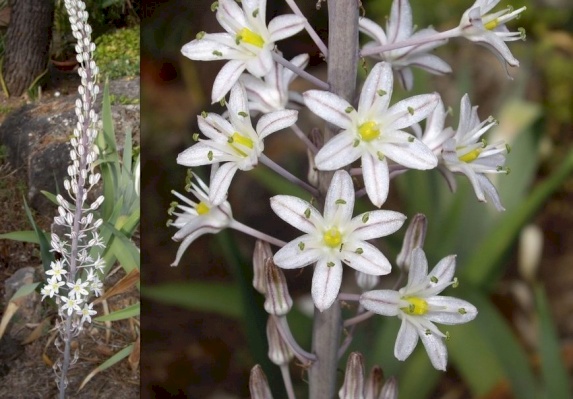Maritime squill
Picture Resource: Urginea maritima 02 (ch.deff) by ch.deff (flickr)
Drimia maritima is a geophyte species of flowering plant in the family Liliaceae, It is native to southern Europe, western Asia, and northern Africa. This plant grows from a large bulb which can be up to 20 cm wide and weigh 1 kg . Several bulbs may grow in a clump and are usually just beneath the surface of the soil. In the spring, each bulb produces a rosette of about ten leaves each up to a meter long. They are dark green in color and leathery in texture. The stem reaches up to 1.5 m height , the leaves are long-lanceolate and entire. The flowers are Perianth-segments free, oblong, white with a green or purple mid-vein; style equalling the stamens. The flowers are hermaphrodite (have both male and female organs) and it is pollinated by insects and wind. Insect pollinators include the western honey bee, the Oriental hornet, and the paper wasp species.
Flowering periods: July, August, September, October.
The fruit is Follicles open when ripe, each containing one smooth, polished, brown seed; pericarp of the seed is brown and wrinkled below.
Ecology: This plant often grows in rocky coastal habitat, especially in the Mediterranean Basin, where it is common. It occurs in many other types of habitat, except for the driest deserts. The plant can tolerates strong winds but not maritime exposure, it follows the Mediterranean botanical Chorotype. Maritime squill is very common in many areas of the Mediterranean and elsewhere, but it is vulnerable to coastal urbanization.
Common and Medical Uses: The plant has been used as a poison and as a medicinal remedy. The main active compounds are cardiac glycosides.This species has been used as a medicinal plant since ancient times. Its primary medicinal use was as a treatment for edema, then called dropsy, because of the diuretic properties of the cardiac glycosides. The plant is also used as a laxative and an expectorant. The plant has also been used as a poison. It is very bitter, so most animals avoid it. Rats, however, eat it readily, and then succumb to the toxic scilliroside. This has made the plant a popular rodenticide for nearly as long as it has been in use as a medicine.
Distributions in Palestine: Mediterranean Woodlands and Shrublands, Semi-steppe shrublands, Shrub-steppes, Deserts and extreme deserts.
Other names: Mededicinal squill, Sea onion.
IUCN red list status: least concern.
Local status: least concern.

